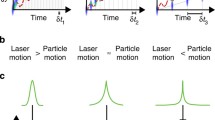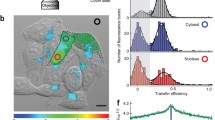Abstract
Protein diffusion in living cells might differ significantly from that measured in vitro. Little is known about the effect of globular protein size on rotational diffusion in cells because each protein has distinct surface properties, which result in different interactions with cellular components. To overcome this problem, the B1 domain of protein G (GB1) and several concatemers of the protein were labeled with 5-fluorotryptophan and studied by 19F NMR in Escherichia coli cells, Xenopus laevis oocytes, and in aqueous solutions crowded with glycerol, or Ficoll70™ and lysozyme. Relaxation data show that the size dependence of protein rotation in cells is due to weak interactions of the target protein with cellular components, but the effect of these interactions decreases as protein size increases. The results provide valuable information for interpreting protein diffusion data acquired in living cells.

Size matters. The protein rotational mobility in living cells was assessed by 19F NMR. The size dependence effect may arise from weak interactions between protein and cytoplasmic components.



Similar content being viewed by others
References
Theillet FX, Binolfi A, Frembgen-Kesner T, Hingorani K, Sarkar M, Kyne C, et al. Physicochemical properties of cells and their effects on intrinsically disordered proteins (IDPs). Chem Rev. 2014;114:6661–714.
Sharp KA. Analysis of the size dependence of macromolecular crowding shows that smaller is better. Proc Natl Acad Sci U S A. 2015;112:7990–5.
Wang YQ, Li CG, Pielak GJ. Effects of proteins on protein diffusion. J Am Chem Soc. 2010;132:9392–7.
Cohen RD, Guseman AJ, Pielak GJ. Intracellular pH modulates quinary structure. Protein Sci. 2015;24:1748–55.
Di Rienzo C, Piazza V, Gratton E, Beltram F, Cardarelli F. Probing short-range protein Brownian motion in the cytoplasm of living cells. Nat Commun. 2014;5:5891.
Baum M, Erdel F, Wachsmuth M, Rippe K. Retrieving the intracellular topology from multi-scale protein mobility mapping in living cells. Nat Commun. 2014;5:4494.
Nenninger A, Mastroianni G, Mullineaux CW. Size dependence of protein diffusion in the cytoplasm of Escherichia coli. J Bacteriol. 2010;192:4535–40.
Zorrilla S, Hink MA, Visser AJWG, Lillo MP. Translational and rotational motions of proteins in a protein crowded environment. Biophys Chem. 2007;125:298–305.
McGuffee SR, Elcock AH. Diffusion, crowding & protein stability in a dynamic molecular model of the bacterial cytoplasm. PLoS Comput Biol. 2010;6:e1000694.
Porter LL, Rose GD. A thermodynamic definition of protein domains. Proc Natl Acad Sci U S A. 2012;109:9420–5.
Hamatsu J, O'Donovan D, Tanaka T, Shirai T, Hourai Y, Mikawa T, et al. High-resolution heteronuclear multidimensional NMR of proteins in living insect cells using a Baculovirus protein expression system. J Am Chem Soc. 2013;135:1688–91.
Sakakibara D, Sasaki A, Ikeya T, Hamatsu J, Hanashima T, Mishima M, et al. Protein structure determination in living cells by in-cell NMR spectroscopy. Nature. 2009;458:102–5.
Inomata K, Ohno A, Tochio H, Isogai S, Tenno T, Nakase I, et al. High-resolution multi-dimensional NMR spectroscopy of proteins in human cells. Nature. 2009;458:106–9.
Li C, Liu M. Protein dynamics in living cells studied by in-cell NMR spectroscopy. FEBS Lett. 2013;587:1008–11.
Monteith WB, Pielak GJ. Residue level quantification of protein stability in living cells. Proc Natl Acad Sci U S A. 2014;111:11335–40.
Bertrand K, Reverdatto S, Burz DS, Zitomer R, Shekhtman A. Structure of proteins in eukaryotic compartments. J Am Chem Soc. 2012;134:12798–806.
Danielsson J, Mu X, Lang L, Wang H, Binolfi A, Theillet FX, et al. Thermodynamics of protein destabilization in live cells. Proc Natl Acad Sci U S A. 2015;112:12402–7.
Theillet FX, Binolfi A, Bekei B, Martorana A, Rose HM, Stuiver M, et al. Structural disorder of monomeric alpha-synuclein persists in mammalian cells. Nature. 2016;530:45–50.
Ye Y, Liu X, Zhang Z, Wu Q, Jiang B, Jiang L, et al. 19F NMR spectroscopy as a probe of cytoplasmic viscosity and weak protein interactions in living cells. Chem Eur J. 2013;19:12705–10.
Wang Q, Zhuravleva A, Gierasch LM. Exploring weak, transient protein–protein interactions in crowded in vivo environments by in-cell nuclear magnetic resonance spectroscopy. Biochemistry. 2011;50:9225–36.
Luh LM, Hansel R, Lohr F, Kirchner DK, Krauskopf K, Pitzius S, et al. Molecular crowding drives active Pin1 into nonspecific complexes with endogenous proteins prior to substrate recognition. J Am Chem Soc. 2013;135:13796–803.
Barbieri L, Luchinat E, Banci L. Protein interaction patterns in different cellular environments are revealed by in-cell NMR. Sci Rep. 2015;5:14456.
Kyne C, Ruhle B, Gautier VW, Crowley PB. Specific ion effects on macromolecular interactions in Escherichia coli extracts. Protein Sci. 2015;24:310–8.
Smith AE, Zhang Z, Pielak GJ, Li C. NMR studies of protein folding and binding in cells and cell-like environments. Curr Opin Struct Biol. 2014;30C:7–16.
Monteith WB, Cohen RD, Smith AE, Guzman-Cisneros E, Pielak GJ. Quinary structure modulates protein stability in cells. Proc Natl Acad Sci U S A. 2015;112:1739–42.
Majumder S, Xue J, DeMott CM, Reverdatto S, Burz DS, Shekhtman A. Probing protein quinary interactions by in-cell nuclear magnetic resonance spectroscopy. Biochemistry. 2015;54:2727–38.
Crowley PB, Kyne C, Monteith WB. Simple and inexpensive incorporation of 19F-tryptophan for protein NMR spectroscopy. Chem Commun. 2012;48:10681–3.
Barnes CO, Pielak GJ. In-cell protein NMR and protein leakage. Proteins. 2011;79:347–51.
Ye Y, Liu X, Xu G, Liu M, Li C. Direct observation of Ca2+-induced calmodulin conformational transitions in intact Xenopus laevis oocytes by 19F NMR spectroscopy. Angew Chem Int Ed. 2015;54:5328–30.
Abragam A. The principles of nuclear magnetism. Oxford: Clarendon Press; 1961.
Luck LA, Vance JE, O'Connell TM, London RE. 19F NMR relaxation studies on 5-fluorotryptophan- and tetradeutero-5-fluorotryptophan-labeled E. coli glucose/galactose receptor. J Biomol NMR. 1996;7:261–72.
Abragam A. The principles of nuclear magnetism. Oxford: Clarendon Press; 1961.
Luginbuhl P, Pervushin KV, Iwai H, Wuthrich K. Anisotropic molecular rotational diffusion in 15N spin relaxation studies of protein mobility. Biochemistry. 1997;36:7305–12.
de la Torre JG, Echenique Gdel R, Ortega A. Improved calculation of rotational diffusion and intrinsic viscosity of bead models for macromolecules and nanoparticles. J Phys Chem B. 2007;111:955–61.
Dürr UH, Grage SL, Witter R, Ulrich AS. Solid state 19F NMR parameters of fluorine-labeled amino acids. Part I: aromatic substituents. J Magn Reson. 2008;191:7–15.
Li C, Wang GF, Wang Y, Creager-Allen R, Lutz EA, Scronce H, et al. Protein 19F NMR in Escherichia coli. J Am Chem Soc. 2010;132:321–7.
Chen H, Viel S, Ziarelli F, Peng L. 19F NMR: a valuable tool for studying biological events. Chem Soc Rev. 2013;42:7971–82.
Rydzik AM, Brem J, van Berkel SS, Pfeffer I, Makena A, Claridge TDW, et al. Monitoring conformational changes in the NDM-1 Metallo-beta-lactamase by F-19 NMR spectroscopy. Angew Chem Int Ed. 2014;53:3129–33.
Williams SP, Haggie PM, Brindle KM. 19F NMR measurements of the rotational mobility of proteins in vivo. Biophys J. 1997;72:490–8.
Trovato F, Tozzini V. Diffusion within the cytoplasm: a mesoscale model of interacting macromolecules. Biophys J. 2014;107:2579–91.
Ye Y, Liu X, Chen Y, Xu G, Wu Q, Zhang Z, et al. Labeling strategy and signal broadening mechanism of protein NMR spectroscopy in Xenopus laevis oocytes. Chem Eur J. 2015;21:8686–90.
Jacobson K, Wojcieszyn J. The translational mobility of substances within the cytoplasmic matrix. Proc Natl Acad Sci U S A. 1984;81:6747–51.
Arrio-Dupont M, Foucault G, Vacher M, Devaux PF, Cribier S. Translational diffusion of globular proteins in the cytoplasm of cultured muscle cells. Biophys J. 2000;78:901–7.
Verkman AS. Solute and macromolecule diffusion in cellular aqueous compartments. Trends Biochem Sci. 2002;27:27–33.
Acknowledgements
We thank Elizabeth Pielak for comments on the manuscript. This work was supported by Ministry of Science and Technology of China grant 2017YFA0505400, Inovation team of Hubei Province grant 2016CFA002, National Natural Sciences Foundation of China grants 21575156, and the US National Science Foundation (MCB-1410854).
Author information
Authors and Affiliations
Corresponding authors
Ethics declarations
All procedures involving animals were performed in accordance with the regulations of the Experimental Animal Administration (State Committee of Science and Technology of the People’s Republic of China) and were approved by the Ethics Committee of Wuhan Institute of Physics and Mathematics.
Conflict of interest
The authors declare that they have no conflict of interest.
Additional information
Published in the topical collection celebrating ABCs 16th Anniversary.
Electronic supplementary material
ESM 1
(PDF 420 kb)
Rights and permissions
About this article
Cite this article
Ye, Y., Wu, Q., Zheng, W. et al. Quantification of size effect on protein rotational mobility in cells by 19F NMR spectroscopy. Anal Bioanal Chem 410, 869–874 (2018). https://doi.org/10.1007/s00216-017-0745-4
Received:
Revised:
Accepted:
Published:
Issue Date:
DOI: https://doi.org/10.1007/s00216-017-0745-4




